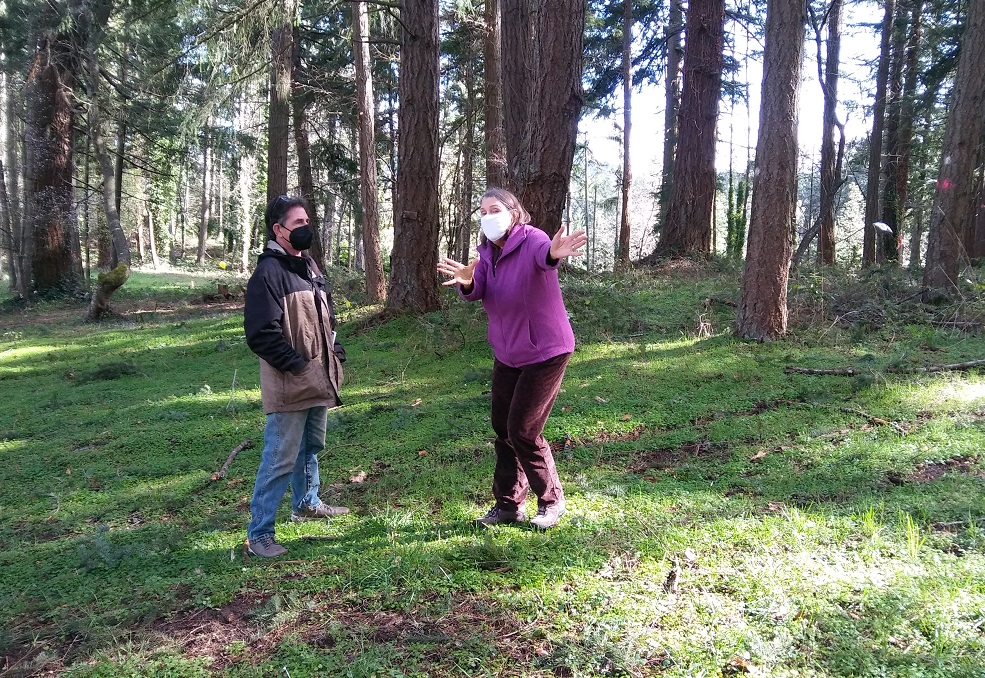Sandra Bishop: ‘One last defense against climate chaos’
8 min read
Sandra Bishop gestures while giving a tour of the Patterson Hill habitat to a neighborhood board member on March 6, 2021.
Jenna: I’m Jenna with the Youth Radio and the KEPW News Team. I’m here with Tejan, and Sandra Bishop. Sandra Bishop is an ex-EWEB commissioner. Right now we are in the forest where EWEB plans to cut down more than 300 trees to put water tanks. Some are very old trees. Right now, I’m just seeing a lot of birds and we saw turkeys with about half a dozen babies and a bunch of plants and the trees are like awesome and twisting, curvy and straight. And there’s a bunch. So Sandra, do you want to show us around?
Sandra Bishop: [00:00:36] Sure, I do. This project up here, there’s over 10 acres, almost 11 acres of land. And it has a uprising of rock in the middle, a rock spine of basalt bedrock, and that’s where the water tanks need to be built to get the right elevation so the water can flow down into the city. So the original plan was to build one [00:01:00] water tank on this site. And that would mean clearing quite a few trees, but we wouldn’t have to clear them all. So when people got alarmed is when the General Manager made an arbitrary decision. He’s a staff person and there’s five elected board members, but the manager said we’re going to build two tanks and cut all the trees because the neighbors had been asking to move the one tank a little bit more to the west to save the heart of the forest. We’ll walk through it later.
So that’s the issue right now, is, they don’t really need to build two tanks up here. Everybody’s fine with building one tank and saving the forest. There’s plenty of land for that. EWEB has other land that they can build water tanks are that does not require clear-cutting a forest.
Thank you for supporting
local citizen journalism
And so they need to really just stop everything up here in the south. And also, [00:02:00] it’s an equity issue, overbuilding capacity for water in the south part of town. Does it make sense when there are other parts of town with failing reservoirs? Those need to be fixed and done quickly as well. So…
Jenna: [00:02:13] That’s a lot of trees, like, to cut down and to be in a forest. And it’s actually kind of sad that this is one of the last forests in the city.
Tejan: [00:02:21] (What’s) so, like, special about this area?
Sandra Bishop: [00:02:25] What’s special about this area is that it’s public land. So it’s accessible to anyone. Anyone can walk up here and when can have a big thing in the meadow every day, I see between 10 and 20 people or groups of people that maybe somebody walks through.
It’s a corridor for wildlife. That’s a really important issue, but it’s one of the last wild, natural places in the city and it’s publicly owned. So, you know, some people have a couple, you know, large trees in their yard or their [00:03:00] lot, but this is an exceptional piece of property and should be developed, if they have to, very carefully.
It’s such a large piece of property that I think it’s 10.74 acres, and one tank takes about an acre. And then if you add roads might take up to two acres, but on a site this large, we can have a water tank, which we need for water storage, but we can also save the forest, the heart of the densest part of this forest. So thanks for asking the question. That was good.
Jenna: [00:03:33] What alternatives are there?
Sandra Bishop: [00:03:35] The alternatives are to go back to the original plan, which was build one tank here. Now I forgot to say this earlier. They had said they were eventually going to build two tanks, but they would build one now and then one, 10 years from now.
So the alternative right now is build one tank here. And then move to the next phase in their water project, which is to decommission or take out the water tank at college [00:04:00] hill and rebuild that one. And that’s been in the plans for many, many years. So that’s the thing to do. I think the only people that can really do anything about it are the five elected board members.
And so if people get a hold of them and say, Hey, you know, don’t do this, you know, look at the alternatives for this. That’s the most effective way the commissioners have delegated all responsibility for all decisions about this project to staff. And so we have to get the commissioners thinking about.
You need to do more than make an engineering decision need to really look at the environmental in the project. And it’s also very expensive. I think we have to ask them where’s the money come from. This is a public utility. It’s public money. That’s going to go to, to build these. So we want to be careful with spending public money, but yeah. So yeah. Look at this wonderful tree.
Jenna: [00:04:57] Yeah. I was just looking at that one. That one is super cool.
Sandra Bishop: [00:05:01] Not in any danger of falling doesn’t look like, and it’s got several different types of habitat in it. And do you know what kind of tree it is?
Jenna: [00:05:08] Maybe a red wood?
Sandra Bishop: [00:05:10] It’s red, literally. It’s red wood, but it’s a Madrone. So you can tell there’s really a diverse, a lot of diverse species up here. It’s not just a Doug fir plantation. This is a naturally growing grove of trees. These trees are older than you. It’s almost inconceivable that anyone elected to represent us now could think that a liquidating or destroying a forest is a good idea, right? It’s just a way to take a longer view and really look at protecting the environment and, you know, just for keeping the lower temperature, keeping the habitat here.
And they have written back to us with very pointed language saying we only want to hear from [00:06:00] the public about things that you can have something to do with, so we’ll come and talk to you about landscape enhancement when the time comes. And it’s just like, ‘Wait a minute, you’re talking about an old forest integrated habitat. You’re going to cut that down and come back with lollipop trees to do landscaping. How many years, how many decades, how many generations is it going to take for a little tiny tree to grow 150 years to provide the kind of habitat that already exists?’ So it’s so frustrating.
Jenna: [00:06:34] Tejan, so far, what do you love about this place?
Tejan: [00:06:37] There’s a lot of animals and I feel like I’m getting a little bit more oxygen in because there’s so many trees here. And we’re going, we’re just liking it over here. What are you liking about it here right now?
Jenna: [00:06:54] I love all the animals and how old the trees are, because they’re like super old to [00:07:00] me. I like seeing all the birds, like they’re super pretty. And we got out of the car and grandma saw turkeys, and then I saw, and grandma told me, go take a picture of them. And I got like super close to them, maybe 20 feet away. And one of them just like froze. And like just looked at me for like 30 seconds. And I probably got like 10 pictures of him just like that, but they had half a dozen babies, maybe more and they just like, the babies would just pop out of nowhere because like, we were so far away, the grass was like tall enough that we couldn’t see all of them at once.
I don’t hear birds like this out at my house because me and my grandma live out in the forest. And like, there’s not as many birds as here because there’s like a road right in front of us. So when we go down to the creek, it sounds like this.
Tejan: [00:07:50] (To Sandra) What do you love about this forest here?
Sandra Bishop: [00:07:53] That it is one last defense against climate chaos. We are [00:08:00] really in a extreme situation with the earth. We cannot afford to destroy any more trees that are pulling water up and breathing water vapor out into the air. It’s absurd. It just makes no sense, especially on public land. So I think this needs to be preserved for the public. For when you guys grow up. When you guys have kids, you should be able to access areas like this.
Jenna: [00:08:29] Yeah. I live out in the forest. If you like drive out from where I live. Okay. There’s a loop and right in that loop, there’s like two lumber mills. It’s super crazy. Do you have anything else to say?
Sandra Bishop: [00:08:42] Yes. I really want to thank you. You have both been very good, really insightful questions and want to thank you sincerely from my heart for looking at these issues, they can be really complicated. But, you know, you are starting to really drill down and [00:09:00] look at what matters to you.
Jenna: [00:09:02] Also, thank you for showing us around and telling us about these issues and stuff. Is there any contact info that we can get if we have any more questions?
Sandra Bishop: [00:09:13] Yeah, sure. Email me at SBishop@pacinfo.com. Certainly I won’t have all the answers, but it might have a way to refer them and can talk to them about it. Also. I really encourage people to just go on the EWEB website. And you can Google this EWEB or Eugene Water and Electric Board and make comments and ask questions of the staff there, and especially put your comments into the EWEB commissioners. They say they’re going to start logging in August. And I’ve heard that they are going to put out contracts at the July 6th EWEB board meetings. [00:10:00] So contact them before that. And also you can sign up the day before a meeting. You can sign up to testify at the board meeting.
Jenna: [00:10:07] Thank you. This has been Jenna Hartman with the Youth Radio and KEPW’s News Team.
Tejan: [00:10:15] Bye bye.


